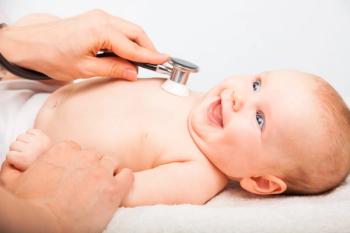
An Australian study examines how childhood wheezing can impact the development of allergies.
Dr Farber is a pediatrician in Woodbridge, Virginia.

An Australian study examines how childhood wheezing can impact the development of allergies.

Three case studies look at the efficacy of using foreskin for syndactyly repair.

A new study examines the efficacy of the toxin for migraine treatment in pediatrics.

Examining how an intensive clinical examination can change the approach to early-onset sepsis.

Smartphone applications addressing weight reduction have increased along with smartphone app use among pediatric patients. What's the best way to choose one?

A recent study examined the impact of a nightly dose of pediatric prolonged-release melatonin on sleep disturbances in children with autism spectrum disorder.

A retrospective study examines whether limited abdominal ultrasound is a safe and effective way to assess for intestinal malrotation with or without midgut volvulus.

A case report examines whether a high-risk child with appendicitis will need surgery.

A study finds that the levonorgestrel intrauterine device (IUD) is successful in controlling abnormal uterine bleeding and in suppressing menses in teenagers.

A pharmacokinetic model suggests that although 4 daily doses of cephalexin are the standard of care for treating methicillin-susceptible Staphylococcus aureus (MSSA) infections, 2- or 3-dose daily regimens (BID or TID) could achieve similar results.

Children are more likely to exhibit troublesome behaviors during meals if their caregivers’ use of mobile phones is “problematic,” according to a study of 84 caregivers and their children.

Children who take proton pump inhibitors (PPIs) are at increased risk of having fractures compared with those who have no PPI exposure, according to a retrospective review of information in the Pediatric Hospital Information System database. Further, likely fracture location differs between those who are exposed to PPIs and those who are not.

Paternal smoking before conception or during pregnancy are both associated with increased risk of acute lymphoblastic leukemia in offspring, and the risk is significant when daily smoking consumption is higher than a certain threshold, according to a recent meta-analysis.

A study in children with asthma showed that a medical and behavioral intervention program delivered by video-based telehealth is feasible and can significantly improve asthma outcomes and care.

A retrospective study in 73 patients aged from 5 to 20 years who underwent laparoscopic appendectomy found that after hospital discharge (within 2 days of surgery) most patients had adequate analgesia without being prescribed opioids.

Second-generation antipsychotics (SGAs), used alone or with other psychotropic medications, are associated with metabolic disturbances, primarily weight gain and losses in triglyceride and high-density lipoprotein (HDL) values, a retrospective study in 128 youngsters showed. However, the changed values usually were within the normal reference values and often were not recognized.

Treatment regimens that include ondansetron as the antiemetic of choice for children who visit a pediatric emergency department for acute migraine are safe and effective, according to a retrospective review.

The American Academy of Pediatrics’ (American Academy of Pediatrics) newly issued recommendations for supervising the health care of children with Williams syndrome are based on a review of the current literature along with the consensus of physicians and psychologists with expertise in managing this condition, which is caused by a deletion of part of chromosome 7.

When added to existing antiepileptic treatment, fenfluramine hydrochloride significantly reduced the frequency of convulsive seizures in children and young adults with Dravet syndrome and had a dose-response effect, according to a randomized trial in patients in whom seizures had not been completely controlled by their current treatment regimen.

Although the American Academy of Pediatrics (AAP) recommends routine screening renal bladder ultrasound (RBUS) after a first febrile urinary tract infection (UTI), a comparison of this strategy with routine RBUS after a second UTI found that the AAP approach does not meet cost-effectiveness guidelines.

A study of hemoglobin A1c (HbA1c) levels that compared levels in normal-weight and obese middle schoolers found that overall distribution of HbA1c was similar in the 2 groups and that the adult-defined cutoff was seen in 2% of normal-weight youth.

Newborn infants with tongue-tie (ankyloglossia) are more likely to have severe breastfeeding problems than infants without the condition, according to an observational study carried out in Germany in newborn mother-infant pairs.

Children who received virtual reality (VR) education before undergoing chest radiography showed lower levels of stress during the procedure than their peers who did not receive the VR exposure, a randomized trial in 99 children found.

A study in 512 mother-child pairs from 6 major cities in Canada found that exposure to higher levels of fluoride during pregnancy was associated with lowered intelligent quotient (IQ) scores in their children at the age of 3 to 4 years.

Palivizumab appears to be effective for reducing respiratory syncytial virus (RSV) in high-risk infants, according to results of a study in Australia.

Dr Farber presents some parting, philosophically oriented views on making sure we stay on the true path to best serve our patients and families.

Often we treat a child without considering the parental role, as when we prescribe an antibiotic to be multiple times a day. Other times we do need to consider the parents. Here are the thoughts from Jon Matthew Farber, MD, on how parents view, interact with, and advocate for their children in these situations.

Jon Matthew Farber, MD, practices in Northern Virginia where he can refer patients to a large variety of pediatric specialists, but he often chooses not to do so. Here are some common conditions/findings that are often referred out that he believes are often unnecessary.

Here are some various observations that have guided my own pediatric practice over the years. Perhaps they will help you with yours.

Complementary and alternative medicine (CAM) to me implies mostly unproven therapies with at least some partial evidence in support. By contrast, “fringe therapies” are more bizarre, with only anecdotal evidence.